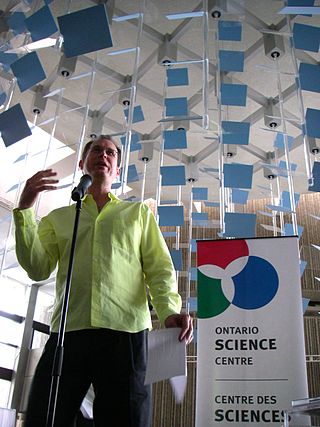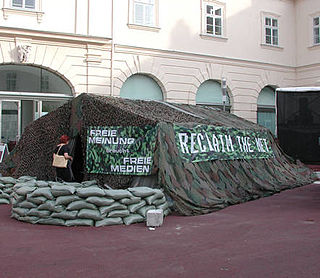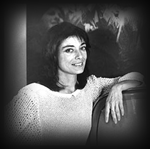
Linz is the capital of Upper Austria and third-largest city in Austria. Sitting on the river Danube, the city is located in the far north of Austria, 30 km (19 mi) south of the border with the Czech Republic. In 2018, the city had a population of 204,846 within its administrative urban area.

Peter Weibel was an Austrian post-conceptual artist, curator, and new media theoretician. He started out in 1964 as a visual poet, then later moved from the page to the screen within the sense of post-structuralist methodology. His work includes virtual reality and other digital art forms. From 1999 he was the director of the ZKM Center for Art and Media Karlsruhe.

David Rokeby is a Canadian artist who has been making works of electronic, video and installation art since 1982. He lives with his wife, acclaimed pianist Eve Egoyan, and daughter, Viva Egoyan-Rokeby, in Toronto, Canada.

Valie Export is an avant-garde Austrian artist. She is best known for provocative public performances and expanded cinema work. Her artistic work also includes video installations, computer animations, photography, sculpture and publications covering contemporary art.
Cyberfeminism is a feminist approach which foregrounds the relationship between cyberspace, the Internet, and technology. It can be used to refer to a philosophy, methodology or community. The term was coined in the early 1990s to describe the work of feminists interested in theorizing, critiquing, exploring and re-making the Internet, cyberspace and new-media technologies in general. The foundational catalyst for the formation of cyberfeminist thought is attributed to Donna Haraway's "A Cyborg Manifesto", third wave feminism, post-structuralist feminism, riot grrrl culture and the feminist critique of the alleged erasure of women within discussions of technology.
Faith Wilding is a Paraguayan American multidisciplinary artist - which includes but is not limited to: watercolor, performance art, writing, crocheting, knitting, weaving, and digital art. She is also an author, educator, and activist widely known for her contribution to the progressive development of feminist art. She also fights for ecofeminism, genetics, cyberfeminism, and reproductive rights. Wilding is Professor Emerita of performance art at the School of the Art Institute of Chicago.

Public Netbase was a cultural media initiative, open access internet platform, media art space, and advocate for the development of electronic art.

Nettime is an internet mailing list proposed in 1995 by Geert Lovink and Pit Schultz at the second meeting of the "Medien Zentral Kommittee" during the Venice Biennale. Since 1998, Ted Byfield and Felix Stalder have moderated the main list, coordinated moderation of other lists in the nettime "family," and maintained the site as their nexus.
Daniel Rozin is an Israeli-American artist working in the area of interactive digital art. As an interactive artist Rozin creates installations and sculptures that have the unique ability to change and respond to the presence and point of view of the viewer. In many cases the viewer becomes the contents of the piece and in others the viewer is invited to take an active role in the creation of the piece.

Cornelia Sollfrank is a German digital artist, she was an early pioneer of Net Art and Cyberfeminism in the 1990s.

The Atelierhaus Salzamt is a cultural institution in the city of Linz, Austria founded in 2009. Its goal is to promote and support international exchange programs in the field of visual arts. The house is located in the centre of Linz, directly on the southern bank of the Danube. It functions as an art gallery, an artists' residence, and a studio space for local and international artists.
Electronic Café International (ECI), established in 1988 by Kit Galloway and Sherrie Rabinowitz, is a performance space and real café housed in the 18th Street Arts Center in Santa Monica, California.
Linda Dement is an Australian multidisciplinary artist, working in the fields of digital arts, photography, film, and writing non-fiction. Dement is largely known for her exploration of the creative possibilities of emergent technologies such as the CD-ROM, 3-D modelling, interactive software, and early computing.

Ars Electronica Linz GmbH is an Austrian cultural, educational and scientific institute active in the field of new media art, founded in Linz in 1979. It is based at the Ars Electronica Center (AEC), which houses the Museum of the Future, in the city of Linz. Ars Electronica's activities focus on the interlinkages between art, technology and society. It runs an annual festival, and manages a multidisciplinary media arts R&D facility known as the Futurelab. It also confers the Prix Ars Electronica awards.

Sherrie Rabinowitz (1950–2013) was an American video artist and a pioneer in satellite-based telecommunications art. She worked exclusively with Kit Galloway under the moniker Mobile Image from 1977 onwards. She co-founded the Electronic Café International (ECI), a performance space and real café housed in the 18th Street Arts Center in Santa Monica, California, with Galloway. She died in 2013, from complications due to multiple sclerosis.
Kathy Rae Huffman is an American curator, writer, producer, researcher, lecturer and expert for video and media art. Since the early 1980s, Huffman is said to have helped establish video and new media art, online and interactive art, installation and performance art in the visual arts world. She has curated, written about, and coordinated events for numerous international art institutes, consulted and juried for festivals and alternative arts organisations. Huffman not only introduced video and digital computer art to museum exhibitions, she also pioneered tirelessly to bring television channels and video artists together, in order to show video artworks on TV. From the early 1990s until 2014, Huffman was based in Europe, and embraced early net art and interactive online environments, a curatorial practice that continues. In 1997, she co-founded the Faces mailing list and online community for women working with art, gender and technology. Till today, Huffman is working in the US, in Canada and in Europe.
Elke Krasny is a cultural and architectural theorist, urban researcher, curator, and author. Her work specializes in architecture, contemporary art, urbanism, feminist museology, histories and theories of curating, critical historiographies of feminism, politics of remembrance, and their intersections. Krasny received her Ph.D. from the University of Reading. She is Professor of Art and Education at the Academy of Fine Arts Vienna. She worked as a visiting professor at the University of Bremen and the Academy of Fine Arts Nuremberg. In 2012 she was visiting scholar at the Canadian Centre for Architecture CCA, Montréal. In 2014, she was City of Vienna Visiting Professor at the Interdisciplinary Centre for Urban Culture and Public Space (SKuOR) at the Vienna University of Technology. Using the framework of political care ethic developed by Joan Tronto, Krasny works on developing a perspective of critical care for architectural and urban practice and theory. In 2019, together with Angelika Fitz she edited Critical Care. Architecture and Urbanism for a Broken Planet.

Margot Pilz is an Austrian visual artist and a pioneer of conceptual and digital art in Austria. She was one of the first Austrian artists to combine computers and photography. Her works reflect the avant-garde culture of the 1960s and 1970s in their experimental techniques and performative aspects. Her work received renewed attention in the 2010s.
Richard Kriesche is an Austrian artist. He is considered one of the most productive and influential contemporary artists in Austria.










